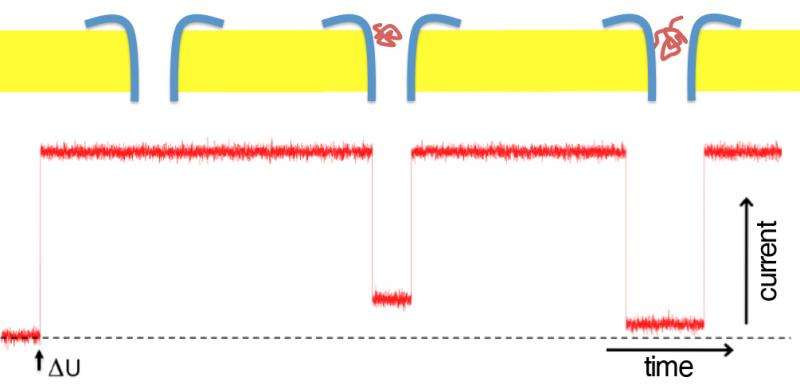Bacterial protein serves as sensor

A German-French team led by Prof. Dr. Jan C. Behrends and Dr. Gerhard Baaken from the University of Freiburg and Dr. Abdelghani Oukhaled from the Universities of Evry and Cergy-Pontoise has developed a method capable of precisely measuring the size of individual molecules. To do so, the researchers used the protein aerolysin from the bacterium Aeromonas hydrophila instead of the protein previously used for this purpose, alpha-hemolysin from the bacterium Staphylococcus aureus. The method remains unchanged: The protein forms a pore in an artificial cell membrane. The researchers insert the molecule whose size they wish to measure into this pore by guiding an ionic current through it. The molecule partially blocks this current - similar to the way an object illuminated by a spotlight throws a shadow. The rest of the ionic current, which makes it through the pore, can then be used to measure the molecule. "The new pore is much more suitable for determining the entire size range of molecules," says Behrends.
The researchers published their findings in the journal ACS Nano.
The key advantage of the new method is that polymers - chain molecules composed of repeating elements - remain in the new pore much longer than a millisecond, while they only stay in the hemolysin pore for less than a millisecond. The method allows scientists to determine the difference in size between two molecules that only differ with regard to a single link of the chain. Polymers like the water-soluble, non-toxic, and non-allergenic polyethylene glycol have a wide range of uses in medicine and biotechnology. For instance, they can enhance the stability of medicinal agents. This requires precise information about how large the links of the chain in the molecule are and how they are distributed. The new and improved method is capable of providing this information - even in the case of short chains whose size was nearly impossible to discriminate with the pore previously used for this purpose. "The technical feasibility of this method for determining the size of water-soluble polymers is thus now within reach," says Behrends.
The research was funded by the international research training group Soft Matter Science of the University of Freiburg and Ionera Techologies GmbH, a University of Freiburg spin-off. Primary author Gerhard Baaken is also the CEO of Ionera. Jan C. Behrends leads the Membrane Physiology and Technology Working Group at the Institute of Physiology of the University of Freiburg's Faculty of Medicine.
More information: "High-Resolution Size-Discrimination of Single Non-Ionic Synthetic Polymers with a Highly Charged Biological Nanopore." ACS Nano, 150531140658005. DOI: 10.1021/acsnano.5b02096
Journal information: ACS Nano
Provided by Albert Ludwigs University of Freiburg



















